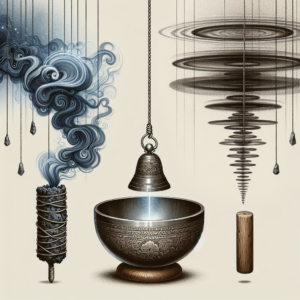
Key Takeaways
- Quantum mechanics may offer a scientific lens through which to view the practice of pendulum dowsing.
- Dowsing is a form of divination that uses a pendulum to interpret subtle energy shifts, often seeking answers to questions or locating underground resources.
- The ideomotor effect is a psychological phenomenon that could explain the pendulum’s movement without invoking supernatural forces.
- Integrating dowsing into spiritual practice can enhance personal intuition and decision-making.
- Understanding the basics of quantum theory and the ideomotor effect can demystify the practice of dowsing and inspire deeper exploration into metaphysical science.
Quantum Theory Fundamentals
Let’s start with the basics: quantum theory. It’s like the rulebook for the tiniest players in the universe – atoms, electrons, photons, and the like. These particles don’t follow the same rules as, say, a soccer ball or a car. Instead, they’re all about probabilities. Imagine you have a box, and inside there’s a little quantum particle zipping around. You can’t say for sure where it is at any moment. Instead, you can only talk about the chances of finding it in one spot or another. That’s quantum mechanics in a nutshell.
Now, why does this matter for something like pendulum dowsing? Well, some folks think that the same sort of unpredictability and ‘action at a distance’ that we see in quantum particles might be at play when a pendulum swings and seemingly answers our questions. Could it be that there’s a sort of quantum communication happening? Let’s keep exploring.
The Pendulum Dowsing Practice
So, what exactly is pendulum dowsing? Picture this: you’re holding a small weight on a string – that’s your pendulum. You ask it a question, and depending on how it swings – in a circle or back and forth – you get your answer. It’s been used for centuries to find water, minerals, and even to answer personal questions. But how does it work?
Some say it’s all about tapping into a deeper, subconscious wisdom. Others believe that the pendulum acts as a receiver for subtle energy shifts in the environment. But the real question is, can science shed light on this ancient practice?
Scientific Explanations for Dowsing Phenomena
One word you’ll hear a lot in discussions about dowsing is the ‘ideomotor effect.’ This is a fancy way of saying that our bodies can move in response to our thoughts without us consciously deciding to make those movements. For example, when you’re thinking about swinging the pendulum, your hand might make tiny, almost invisible movements that cause the pendulum to move – all without you actively moving it.
Because of this, some scientists say that the pendulum is just reflecting our subconscious thoughts through these tiny muscle movements. It’s not that the pendulum has any special powers; it’s more about what’s going on inside us.
But let’s not stop there. Dowsing, with its mysterious allure, invites us to look deeper. Can the principles of quantum mechanics, which govern the realm of the very small, provide a bridge to understanding the pendulum’s sway? Stick with me as we delve into the particles and probabilities that might just underpin the pendulum’s dance.
What Dowsing Reveals: Reading Subtle Energy Shifts
Those who practice dowsing often speak of sensing subtle energy shifts in the environment. Imagine you’re in a field, and beneath your feet runs an underground stream. Dowsers would say that the pendulum can detect the energy difference caused by that stream. It’s a bit like feeling a breeze on your skin, except it’s an energy breeze that only the pendulum can detect.
This idea isn’t too far off from what scientists call ‘locality’ in quantum mechanics. In the quantum world, particles can be affected by forces or other particles without being directly touched, much like our pendulum seemingly responds to unseen energies. It’s a stretch, but who’s to say that the quantum world doesn’t have more surprises for us?
Understanding the Ideomotor Response
Let’s dive deeper into the ideomotor effect. It’s not magic; it’s your brain talking to your body without looping in your conscious mind. You think a thought, and that thought makes tiny muscles in your hand twitch, which then makes the pendulum swing. It’s like when you’re just about to fall asleep, and you dream of tripping – your body jerks, even though you didn’t tell it to. That’s your ideomotor response in action.
When it comes to dowsing, your subconscious mind is the one doing the talking. You might not realize it, but your body could be reacting to your thoughts and beliefs, and that’s what’s swinging the pendulum. This doesn’t mean that the answers you get from dowsing are meaningless – they could be insights from your subconscious, which might know more than you give it credit for.
Psychology meets Quantum Physics: The Mind-Matter Connection
Here’s where things get really interesting. Quantum physics tells us that observers can affect the outcome of experiments just by watching. This is called the observer effect. So, if we think about dowsing through this lens, could it be that our expectations influence the way the pendulum swings?
It’s a wild thought, but it’s not out of the question. If the act of observing can change the behavior of particles, maybe the act of asking a question can influence the pendulum. This connection between mind and matter is at the heart of many metaphysical practices and is what keeps the door open to new possibilities in dowsing.
Now, I’m not saying that every swing of a pendulum is a quantum event. But, isn’t it fascinating to consider that our thoughts might have the power to reach out and touch the world in ways we don’t fully understand yet? It’s these questions that drive our curiosity and keep us searching for answers.
- Keep an open mind – the universe is full of mysteries waiting to be explored.
- Remember that both psychology and quantum physics suggest our thoughts have more power than we realize.
- Consider the possibility that dowsing might be more than just an ideomotor response – it could be a connection to the quantum world.
So, as we ponder the mind-matter connection, let’s stay curious and keep asking questions. Who knows what we’ll discover next?
Intersecting Paths: When Science Meets Mysticism
Science and mysticism often seem like two separate roads that never cross. But when we talk about dowsing and quantum mechanics, it’s like they’re walking side by side. On one hand, we have a divination tool used for centuries, steeped in tradition and mystery. On the other, we have the cutting-edge science of the very small, where things don’t always make sense in the ways we expect.
It’s this intersection that makes the study of dowsing so compelling. Are we simply witnessing the power of suggestion at work, or is there a deeper, more profound scientific principle at play? The debate is ongoing, and research continues to peel back the layers of this enigmatic practice.
Debunked or Validated: Recent Research on Dowsing
In recent years, there have been studies trying to validate or debunk the practice of dowsing. While some experiments have shown dowsers successfully locating water or other substances, skeptics argue that these successes could be due to chance or the dowsers’ prior knowledge of the area.
However, other research suggests that there might be something more going on. For instance, some studies have looked at the success rate of dowsers under controlled conditions, finding that they perform better than mere chance would allow. While this doesn’t prove a quantum connection, it does suggest that dowsing might tap into some kind of subtle perception or intuition that we don’t fully understand yet.
Quantum Entanglement and Information Transference
Quantum entanglement is a phenomenon where particles become linked, so that the state of one instantly influences the state of another, no matter how far apart they are. This ‘spooky action at a distance’, as Einstein called it, could be an analogy for how dowsing works. Could the pendulum be entangled with the energy or information it’s seeking?
This idea is purely speculative, of course. But in the spirit of curiosity, it’s worth considering all possibilities. If quantum entanglement can happen between particles, perhaps a similar kind of connection is possible between our minds and the world around us, with the pendulum acting as a bridge.
Critical Insights: What Seekers Should Know About Dowsing
If you’re interested in exploring dowsing, here’s what you should know. Dowsing is a personal journey, and like any skill, it requires practice. It’s also a tool for introspection, often reflecting our own thoughts and feelings. So, approach dowsing with an open heart and a keen sense of self-awareness.
How to Integrate Dowsing into Spiritual Practice
Integrating dowsing into your spiritual practice can be a rewarding experience. Start by finding a quiet place where you can focus. Hold the pendulum and ask it simple yes or no questions at first. Pay attention to how it moves and what those movements mean to you. Over time, you’ll develop a deeper connection with your pendulum and what it’s trying to communicate.
Enhancing Decision-Making with Intuitive Tools
Dowsing can also be a tool for enhancing decision-making. By tuning into your intuition and the subtle cues around you, you can use the pendulum to explore different options and potential outcomes. Remember, the pendulum is not making decisions for you; it’s helping you to tap into your own inner wisdom.
Whether you’re looking for guidance on a personal matter or trying to make a practical decision, the pendulum can serve as a physical manifestation of your intuition. It’s a way to bypass the chatter of the conscious mind and access the insights of the subconscious.
Expanding the Boundaries of Knowledge
As we continue to explore the realms of quantum mechanics and dowsing, we’re expanding the boundaries of what we know about the world and ourselves. The practice of dowsing, once considered purely mystical, now invites us to question the very fabric of reality.
Most importantly, whether you’re a seasoned dowser or a curious newcomer, keep an open mind. The journey into the quantum world and the mysteries of the mind is bound to be full of surprises, challenges, and, above all, discoveries that could change the way we see everything.
Case Studies: When Dowsing Encounters Skepticism
Dowsing has had its fair share of skeptics. Some see it as a pseudoscience, unworthy of serious consideration. However, there are numerous case studies where dowsing has been used successfully, particularly in finding water sources. For instance, in arid regions, experienced dowsers have been known to locate groundwater where modern technology has failed. While these success stories are compelling, they are often dismissed by skeptics as the result of chance or confirmation bias.
Yet, these case studies serve as an invitation to explore the unknown. They challenge us to consider that there may be aspects of our reality that we have yet to understand fully. Whether or not one believes in dowsing, these stories underscore the importance of keeping an open mind and recognizing that our current scientific understanding is always evolving.
Future Prospects: Quantum Technologies and Consciousness Research
Looking ahead, the intersection of quantum technologies and consciousness research holds great promise. As our tools for measuring and understanding quantum phenomena become more sophisticated, we may find new ways to investigate the potential quantum underpinnings of practices like dowsing. Consciousness research, too, is breaking new ground, exploring the profound connections between the mind, the body, and the external world.
Imagine a future where we can harness quantum entanglement for communication, or where we can measure the subtle energies that dowsers claim to feel. The implications for science, technology, and our understanding of reality itself are profound. As we continue to push the boundaries of what’s possible, dowsing and other metaphysical practices may find a new place in the tapestry of validated human knowledge.
- Keep an open mind as quantum technologies and consciousness research evolve.
- Recognize that practices like dowsing may one day be understood in the context of advanced scientific frameworks.
- Stay informed about breakthroughs in these fields, as they may reshape our understanding of metaphysical practices.
FAQ: Addressing Common Curiosities and Skepticism
How can quantum mechanics relate to pendulum dowsing?
Quantum mechanics, with its principles of superposition and entanglement, suggests that particles can be connected in ways that defy classical understanding. Some theorize that a similar connection could exist between a dowser’s intent and the pendulum’s movement. While this is speculative and not scientifically proven, it’s an area ripe for exploration, especially as we learn more about the role of the observer in quantum systems.
Is there evidence to support dowsing as a reliable practice?
While there is anecdotal evidence and some studies suggesting that dowsing can be effective, it remains a controversial topic. The scientific community often requires reproducible results under controlled conditions to validate such practices. Dowsing has produced mixed results in this regard, and therefore, its reliability is still debated.
Can pendulum dowsing be explained through the ideomotor effect?
Yes, many scientists believe that the ideomotor effect explains pendulum dowsing. This psychological phenomenon occurs when a person’s thoughts or expectations cause unconscious muscle movements. These subtle movements can then cause the pendulum to swing in a particular direction, which the dowser interprets as a response.
What are some practical applications of pendulum dowsing?
Pendulum dowsing has been used for various purposes, including finding water sources, locating lost objects, and making personal decisions. Some people use it as a tool for introspection, tapping into their subconscious to uncover insights or resolve internal conflicts. While its efficacy is debated, many dowsers claim positive results in these areas.
Where can one learn more about quantum physics principles relevant to dowsing?
To learn more about quantum physics principles that could be relevant to dowsing, one can start with introductory books on quantum mechanics, online courses, or lectures from universities and educational platforms. Institutions like the MIT OpenCourseWare and Khan Academy offer free resources that cover the basics of quantum theory. For those interested in the intersection of quantum physics and consciousness, organizations such as the Institute of Noetic Sciences conduct research and provide information on this cutting-edge topic.



